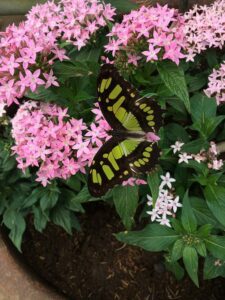How to Stop Pentas from Wilting

Pentas are warm-season plants that thrive best in the full sun, these flowering beauties grow 18 to 36 inches, pentas can be grown as annuals but in warmer regions, pentas are viewed as perennials. Pentas can be used as bedding plants, as border plants, and can be grown in containers and hanging baskets, I have worked with pentas on several garden projects, and know that these plants are worth the effort of keeping them growing healthy
Besides their colorful showery starlike flower bloom, these garden beauties attract wildlife ( hummingbirds) and Pollinators ( bees and butterflies) so if you’re planting a garden to attract wildlife this is the ideal plant for you. Pentas like other garden plants have their issues but with the right knowledge, we can correct many of these problems. One issue we will be discussing is what causes pentas to wilt and how to correct penta wilt so your pentas can continue to grow healthy.
Poor Soil Drainage
For pentas to perform their best requires the right soil type, pentas thrive best in a moist-well drained soil, soils that are too soggy or have poor drainage will lead to root rot and soils that are too sandy meaning water drains through very quickly can also affect the way your penats response.
The Correct Soil pH
The soil pH level for pentas to grow healthy is 6.5-7.5, this will encourage an abundance of flower blooms. Soil that’s acidic will damage the penta’s root system which will interfere with how pentas take up water and nutrients. When this happens your pentas will become leggy and wilt.
Overwatering
Overwatering can lead to penta wilt because the soil is too soggy or waterlogged, root rot will set in so get to know the proper water requirements for pentas, the soil should be moist but well-drained.
A Lack of Water
A lack of water can bring on penta wilt again it’s all a matter of giving your pentas the correct amount of water.
Extreme Heat
In their young stages, pentas are sensitive to extreme heat because the roots are not established, pentas thrive best in temperatures that are anywhere from 22-25 degrees Celsius or higher. But once temperatures reach 35 degrees Celsius the leaves will being to wilt, the leaves will become brown followed by the dropping of leaves.
Freezing Temperatures
Pentas are warm-season plants that love the warm weather so it’s natural when the colder months arrive for pentas to show signs of wilting, in the extreme cold (20°F) the leaves and the stem of pentas will become black. To avoid your pentas from freezing transplant them into containers and place the containers inside or in another protected area from the cold. Once the sun appears move your pentas into that area to get some sun then bring them back indoors.
Pest Problems
Garden pests can also cause pentas to wilt, once insects are discovered on your pentas quick action should be taken, spider mites and aphids are two pests to keep a watch out for. These garden pests dose damage by sucking the plant’s sap. Signs of these pests’ infestation include stunted growth, pentas will also turn yellow and begin to wilt. These insects can be found hiding on the undersides of the plant’s leaves. Using insecticides such as insecticidal soap and horticultural oil will bring control, before applying insecticides read and follow the manufacturer’s directions for the best results.
Disease Issues
There is an old saying which is so true and that is “prevention is better than cure” many garden plants could have been saved if only the proper measures were taken but even if your garden plants fall prey to disease there still may be hope depending on the type of the disease and the stage which it is at. In the case of Pentas to avoid root rot allow the soil to dry between watering and when giving your pentas a drink of water avoid water getting on the leaves and the flowers. When watering water from the ground or the soil level.
In Case you Missed it here are other Topics on Pentas
The final word on how to stop my pentas from wilting
Correcting wilting of your pentas or avoiding penta wilt is possible, all it takes is some knowing how to correct this issue, and you have come to the right place. This guide will help you to strike back and grow healthy pentas that are full of an abundance of beautiful flower blooms. These warm-season plants will go to work for us as long as we go to work for them by ensuring their healthy growth.
About the author
Norman loves being in the garden, both at home and for his job....
he is 'Natures Little helper' being outdoors, growing his vegetables and flowers from an early age.
Now having spent over 22 years in the profession he want to give some of his knowledge to others...
his vast array of hints and tips you will find scattered over this site will help you no end growing plants in your garden.
